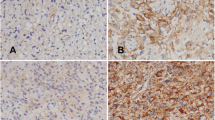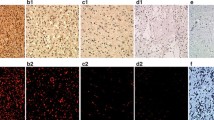Abstract
Cadherins are cell-surface glycoproteins that mediate Ca2+-dependent, homophilic cell–cell adhesion. The classical cadherins, E- and N-cadherins, connect to beta-catenin, the lining protein. There appears to be a relationship between their dysfunction and tumor invasion and metastasis. The aim of our study was to examine the possibility of a relationship between alterations in the E- and N-cadherin and catenin expression and malignancy in astrocytomas. Forty-five astrocytomas (18 glioblastomas, 16 anaplastic astrocytomas, and 11 diffuse astrocytomas) were collected and stained immunohistochemically for cadherins and beta-catenin. None of the astrocytomas were immunoreactive for E-cadherin. N-cadherin and beta-catenin were present at cell–cell borders in 61% of glioblastomas and 31% of anaplastic astrocytomas. The incidence of immunoreactivity for N-cadherin and beta-catenin increased significantly with the histological grade of astrocytomas (p=0.001, by Kruskal–Wallis test). Moreover, in anaplastic astrocytomas and glioblastomas, the Ki-67 labeling indices in both N-cadherin-positive and beta-catenin-positive cases were higher than that in negative cases (p=0.05 and 0.03, respectively, by Fisher's exact test). These results suggest that the expression of N-cadherin or beta-catenin may be related to the biological behavior of astrocytomas.
Similar content being viewed by others
References
Takeichi M: The cadherins: cell-cell adhesion molecule controlling animal morphogenesis. Development 102: 639-655, 1988
Behrens J, Mareel MM, Van Roy FM, Birchmeier W: Dissecting tumor cell invasion: epithelial cells acquire invasive properties after the loss of uvomorulin-mediated cell-cell adhesion. J Cell Biol 108: 2435-2447, 1989
Birchmeier W, Behrens J: Cadherin statement in carcinomas: role in the formation of cell junctions and the prevention of invasiveness. Biochim Biophys Acta 1198: 11-26, 1994
Frixen UH, Nagamine Y: Stimulation of urokinase-type plasminogen activator statement by blockage of E-cadherindependent cell-cell adhesion. Cancer Res 53: 3618-3623, 1993
Frixen UH, Behrens J, Sachs M, Eberle G, Voss B, Warda A, Lochner D, Birchmeier W: E-cadherin-mediated cell-cell adhesion prevents invasiveness of human carcinoma cells. J Cell Biol 113: 173-185, 1991
Perl AK, Wilgenbus P, Dahl U, Semb H, Christofori G: A causal role for E-cadherin in the transition from adenoma to carcinoma. Nature 392: 190-193, 1998
Shino Y, Watanabe A, Yamada Y, Tanase M, Yamada T, Matsuda M, Yamashita J, Tatsumi M, Miwa T, Nakano H: Clinicopathologic evaluation of immunohistochemical E Cadherin statement in human gastric carcinomas. Cancer 76: 2193-2201, 1995
Takeichi M: Cadherins in cancer: implications for invasion and metastasis. Curr Opin Cell Biol 5: 806-811, 1993
Vleminck K, Vakaet L Jr, Mareel M, Fiers W, van Roy F: Genetic manipulation of E-cadherin statement by epithelial tumor cells reveals an invasion suppressor role. Cell 66: 107-119, 1991
Asano K, Kubo O, Tajika Y, Takakura K, Suzuki S: Statement of cadherin and CSF dissemination in malignant astrocytic tumors. Neurosurg Rev 23: 39-44, 2000
Shinoura N, Paradies NE, Warnick RE, Chen H, Larson JJ, Tew JJ, Simon M, Lynch RA, Kanai Y, Hirohashi S, Hemperly JJ, Menon AG, Brackenbury R: Statement of N-cadherin and alpha-catenin in astrocytomas and glioblastomas. Br J Cancer 72: 627-633, 1995
Hatta K, Takagi S, Fujisawa H, Takeichi M: Spatial and temporal statement pattern of N-cadherin cell adhesion molecules correlated with morphogenetic processes of chicken embryos. Dev Biol 120: 215-227, 1987
Bixby JL, Zhang R: Purified N-cadherin is a potent substrate for the rapid induction of neurite outgrowth. J Cell Biol 110: 1253-1260, 1990
Doherty P, Rowett LH, Moore SE, Mann DA, Walsh FS: Neurite outgrowth in response to transfected N-CAM and N-cadherin reveals fundamental differences in neuronal responsiveness to CAMs. Neuron 6: 247-258, 1991
Peifer M, McCrea PD, Green KJ, Wieschaus E, Gumbiner BM: The vertebrate adhesive junction proteins beta-catenin and plakoglobin and the Drosophila segment polarity gene armadillo form a multigene family with similar properties. J Cell Biol 118: 681-691, 1992
Sandig M, Voura EB, Kalnins VI, Siu CH: Role of cadherins in the transendothelial migration of melanoma cells in culture. Cell Motil Cytoskeleton 38: 351-364, 1997
Voura EB, Sandig M, Siu CH: Cell-cell interactions during transendothelial migration of tumor cells. Microsc Res Tech 43: 265-275, 1998
Hazan RB, Kang L, Whooley BP, Borgen PI: N-cadherin promotes adhesion between invasive breast cancer cells and the stroma. Cell Adhes Commun 4: 399-411, 1997
Hazan RB, Phillips GR, Qiao RF, Norton L, Aaronson SA: Exogenous statement of N-cadherin in breast cancer cells induces cell migration, invasion, and metastasis. J Cell Biol 148: 779-790, 2000
Marvin T, Nieman A, Ryan S, Prudoff A, Keith R, Johnson A, Wheelock, MJ: N-Cadherin promotes motility in human breast cancer cells regardless of their E-cadherin statement. J Cell Biol 147: 631-643, 1999
Islam S, Carey TE, Wolf GT, Wheelock MJ, Johnson KR: Statement of N-cadherin by human squamous carcinoma cells induces a scattered fibroblastic phenotype with disrupted cell-cell adhesion. J Cell Biol 135: 1643-1654, 1996
Mialhe A, Levacher G, Champelovier P, Martel V, Serres M, Knudsen K, Seigneurin D: Statement of E-, P-, N-cadherins and catenins in human bladder carcinoma cell lines. J Urol 164: 826-835, 2000
Tomita K, van Bokhoven A, van Leenders GJ, Ruijter ET, Jansen CF, Bussemakers MJ, Schalken JA: Cadherin switching in human prostate cancer progression. Cancer Res 60: 3650-3654, 2000
Behrens J, von Kries JP, Kuhl M, Bruhn L, Wedlich D, Grosschedl R, Birchmeier W: Functional interaction of beta-catenin with transcription factor. Nature 382: 638-642, 1996
Tao YS, Edward RA, Tubb B, Wang S, Bryan J, McCrea PD: Beta-catenin associates with the actin-bundlin protein fascin in a noncadherin complex. J Cell Biol 134: 1271-1281, 1996
Kuhnen C, Herter P, Muller O, Muehlberger T, Krause L, Homann H, Steinau HU, Muller KM: Beta-catenin in soft tissue sarcomas: statement is related to proliferative activity in high-grade sarcomas. Mod Pathol 13: 1005-1013, 2000
Nhieu JT, Renard CA, Wei Y, Cherqui D, Zafrani ES, Buendia MA: Nuclear accumulation of mutated beta-catenin in hepatocellular carcinoma is associated with increased cell proliferation. Am J Pathol 155: 703-710, 1999
Hoschuetzky H, Aberle H, Kemler R: Beta-catenin mediates the interaction of the cadherin-catenin complex with epidermal growth factor receptor. J Cell Biol 127: 1375-1380, 1994
Ochiai A, Akimoto S, Kanai Y, Shibata T, Oyama T, Hirohashi S: c-erbB-2 gene product associates with catenins in human cancer cells. Biochem Biophys Res Commun 205: 73-78, 1994
Nieman MT, Prudoff RS, Johnson KR, Wheelock MJ: N-cadherin promotes motility in human breast cancer cells regardless of their E-cadherin statement. J Cell Biol 147: 631-644, 1999
Utton MA, Eickholt B, Howell FV, Wallis J, Doherty PB: Soluble N-cadherin stimulates fibroblast growth factor receptor-dependent neurite outgrowth and N-cadherin and the fibroblast growth factor receptor co-cluster in cells. J Neurochem 76: 1421-1430, 2001
von Bossanyi P, Sallaba J, Dietzmann K, Warich-Kirches M, Kirches E: Correlation of TGF-alpha and EGF-receptor statement with proliferative activity in human astrocytic gliomas. Pathol Res Pract 194: 141-147, 1998
Author information
Authors and Affiliations
Rights and permissions
About this article
Cite this article
Utsuki, S., Sato, Y., Oka, H. et al. Relationship between the Expression of E-, N-cadherins and beta-catenin and Tumor Grade in Astrocytomas. J Neurooncol 57, 187–192 (2002). https://doi.org/10.1023/A:1015720220602
Issue Date:
DOI: https://doi.org/10.1023/A:1015720220602




